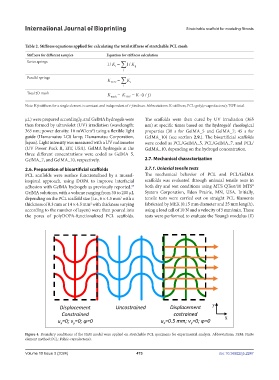Page 481 - IJB-10-3
P. 481
International Journal of Bioprinting Stretchable scaffold for modeling fibrosis
Table 2. Stiffness equations applied for calculating the total stiffness of stretchable PCL mesh
Stiffness for different samples Equation for stiffness calculation
Series springs
i ∑
1/ K = 1/ K ij
j
Parallel springs
=
K TOT ∑ K i
i
Total 2D mesh K mesh = K TOT = Ki j⋅ (/ )
Note: Kij stiffness for a single element is constant and independent of i-j indexes. Abbreviations: K: stiffness; PCL: poly(ε-caprolactone); TOT: total.
µL) were prepared accordingly, and GelMA hydrogels were The scaffolds were then cured by UV irradiation (365
then formed by ultraviolet (UV) irradiation (wavelength: nm) at specific times based on the hydrogels’ rheological
365 nm; power density: 10 mW/cm ) using a flexible light properties (30 s for GelMA_5 and GelMA_7; 45 s for
2
guide (Hamamatsu LC8 lamp, Hamamatsu Corporation, GelMA_10) (see section 2.9.). The bioartificial scaffolds
Japan). Light intensity was measured with a UV radiometer were coded as PCL/GelMA_5, PCL/GelMA_7, and PCL/
(UV Power Puck II, EIT, USA). GelMA hydrogels at the GelMA_10, depending on the hydrogel concentration.
three different concentrations were coded as GelMA_5,
GelMA_7, and GelMA_10, respectively. 2.7. Mechanical characterization
2.6. Preparation of bioartificial scaffolds 2.7.1. Uniaxial tensile tests
PCL scaffolds were surface functionalized by a mussel- The mechanical behavior of PCL and PCL/GelMA
inspired approach, using DOPA to improve interfacial scaffolds was evaluated through uniaxial tensile tests in
adhesion with GelMA hydrogels as previously reported. both dry and wet conditions using MTS QTest/10 MTS®
33
GelMA solutions, with a volume ranging from 30 to 200 µL System Corporation, Eden Prairie, MN, USA. Initially,
depending on the PCL scaffold size (i.e., 6 × 4.5 mm with a tensile tests were carried out on straight PCL filaments
2
thickness of 0.3 mm or 14 × 4.5 mm with thickness varying fabricated by MEX (0.15 mm diameter and 25 mm length),
2
according to the number of layers) were then poured into using a load cell of 10 N and a velocity of 5 mm/min. These
the pores of polyDOPA-functionalized PCL scaffolds. tests were performed to evaluate the Young’s modulus (E)
Figure 4. Boundary conditions of the FEM model were applied on stretchable PCL specimens for experimental analysis. Abbreviations: FEM: Finite
element method; PCL: Poly(ε-caprolactone).
Volume 10 Issue 3 (2024) 473 doi: 10.36922/ijb.2247

